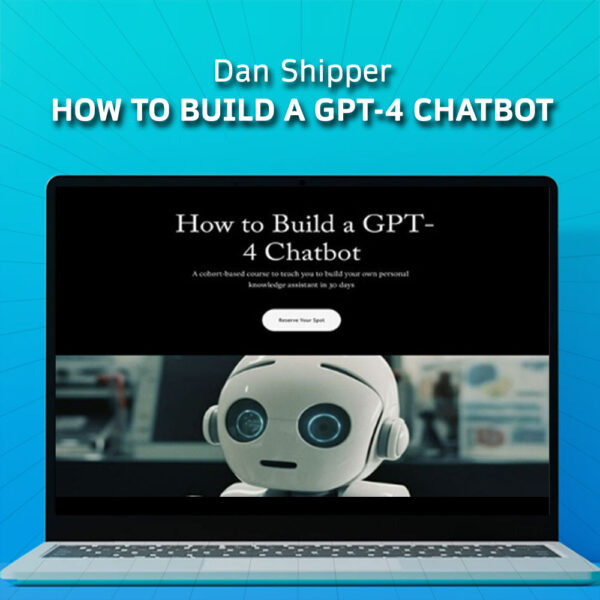Description
Dan Shipper – How to Build a GPT-4 Chatbot
![]()
How to Build a GPT-4 Chatbot: Unleashing the Power of Advanced AI
Building a state-of-the-art GPT-4 chatbot goes beyond simply understanding its fundamental architecture. This guide outlines a comprehensive approach to create a next-level chatbot using GPT-4, incorporating advanced techniques for deployment, user experience, and optimization.
Understanding GPT-4’s Architecture
GPT-4 is a revolutionary model in the realm of conversational AI, offering exceptional natural language processing (NLP) capabilities. It excels in context comprehension, nuanced conversations, and complex query resolutions. The key to harnessing GPT-4’s full potential lies in understanding its architecture based on transformer models, which are optimized for generating human-like text by processing vast amounts of data.
Key advantages of GPT-4:
- Contextual Understanding: The model can maintain and understand context over long conversations.
- Rich Nuance Processing: It handles subtleties in language, making interactions feel more natural.
- Complex Query Resolution: It can provide accurate responses to intricate questions across various domains.
Setting Up the Development Environment
Before diving into chatbot development, you must set up the right development infrastructure:
- Framework: Use PyTorch or TensorFlow for developing with GPT-4. These libraries support advanced machine learning tasks and offer the flexibility needed for fine-tuning and scaling.
- APIs: Consider using OpenAI’s API for accessing GPT-4, as it simplifies integration and scales as needed.
- Cloud Infrastructure: For large-scale deployment, rely on cloud platforms like AWS or Google Cloud for better performance and scalability.
Preprocessing and Fine-Tuning GPT-4
1. Data Preprocessing
Quality data is crucial for a high-performing chatbot. Preprocess your training data by ensuring it covers a wide variety of linguistic contexts, including domain-specific language. Techniques such as data augmentation can also help diversify your dataset.
- Data Types: Text data should cover multiple conversational styles, technical jargon, informal slang, and different cultural contexts to improve chatbot adaptability.
2. Fine-Tuning for Specific Domains
To tailor GPT-4 to your specific audience, fine-tune it using domain-relevant datasets. For instance, if you’re developing a customer service chatbot, train it on support tickets, FAQs, and customer interaction logs.
- Training: Leverage fine-tuning to improve performance in specific use cases (e.g., healthcare, finance, or technical support).
- Hyperparameters: Adjust hyperparameters such as learning rate and batch size to optimize the training process.
Creating a Dynamic User Experience
1. Engaging Conversations
GPT-4 chatbots should be able to hold engaging, meaningful conversations. Focus on creating context-aware and flowing dialogue by using memory features that help the model retain and apply information across conversations.
- Context Memory: Store information from earlier parts of the conversation and reference it in later responses.
- Dialog Flow: Make sure responses are coherent and follow a natural conversational trajectory.
2. Multimodal Interactions
For a richer, more interactive user experience, build capabilities for multimodal inputs—allowing the chatbot to process and respond to images, voice inputs, or even videos alongside text.
- Speech-to-Text/Voice Recognition: Integrate voice recognition for spoken interactions.
- Visual Inputs: Leverage image processing to handle inputs like screenshots or photos.
Resource Efficiency and Scalability
Scalability is vital for handling a growing user base. Ensure that your GPT-4 chatbot can function under heavy loads by:
- Optimizing Backend Resources: Adjust server-side performance to reduce latency and costs.
- Scaling on Demand: Use autoscaling features available in cloud services to meet traffic spikes without downtime.
- Efficient Memory Usage: Fine-tune memory and processing power allocation to optimize performance while handling multiple requests.
Continuous Learning and Improvement
1. Adaptive Learning
Move beyond static models by integrating continuous learning mechanisms. This allows your GPT-4 chatbot to evolve based on user interactions, refining its responses over time.
- Feedback Loops: Implement feedback mechanisms that allow users to rate chatbot responses, contributing to continuous model refinement.
- Dynamic Updates: Regularly update the training data to incorporate new trends, phrases, and industry knowledge.
2. A/B Testing
Run frequent A/B tests on conversation flows, response styles, and message timing. Use the test results to fine-tune chatbot behavior for increased user engagement and conversion rates.
Monitoring and Maintenance
After deployment, the chatbot requires ongoing monitoring and analysis to ensure optimal performance:
- Monitoring Tools: Use tools like Google Analytics or custom dashboards to track key performance indicators (KPIs) such as response time, engagement rates, and sentiment analysis.
- Error Handling: Build robust error-handling systems to manage incomplete inputs or unrecognized queries.
- User Feedback: Regularly gather and act on user feedback to improve the quality and relevance of the chatbot’s responses.
Conclusion: Building a Superior GPT-4 Chatbot
Building a successful GPT-4 chatbot involves more than just setting up the model—it requires thoughtful customization, seamless deployment, and continuous enhancement. By focusing on advanced techniques such as fine-tuning, multimodal interactions, and continuous learning, you can create a chatbot that excels in delivering human-like, engaging conversations. A GPT-4 chatbot, when developed strategically, can dramatically improve user engagement, satisfaction, and business outcomes.













